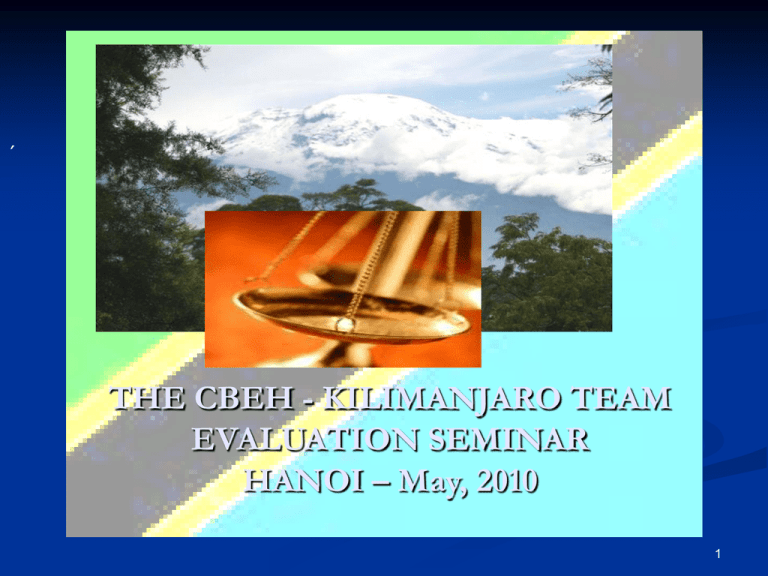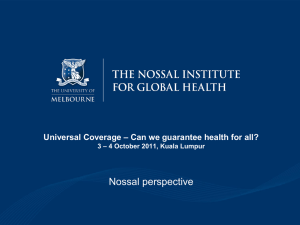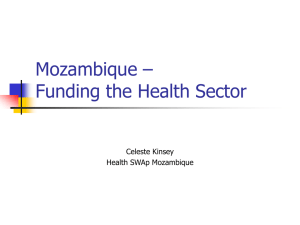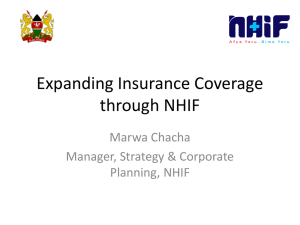Health Insurance in Tanzania
advertisement

’ THE CBEH - KILIMANJARO TEAM EVALUATION SEMINAR HANOI – May, 2010 1 Towards Universal Health Insurance in Tanzania ‘‘Operational experiences of Health Insurance Regulations from different countries and their practical applicability in Tanzania’’ 2 Why the topic A move towards SHI is a core element of the government’s HF policy: NHIF is a best example Fits with the current debate in the region and global WB, WHO: 2005 Assembly called for all HS to move to Universal coverage ‘‘access to adequate health care for all at an affordable price’’ ABUJA Declaration, MGD (Link health and poverty): Half poverty by 2015 ILO/GTZ: Social Health Protection 3 More examples In most developing countries providing affordable health care is high on the development agenda, given the large numbers of people lacking sufficient financial means to access health services 4 while In most developed the agenda is towards guaranteeing the accessibility of healthcare despite the increasing costs, financial constraints of public budgets and economic considerations 5 Methodology: Tools Multiple Desk review Interviews - More than 14 (Annex) FDG - 14 Participants (Experts) 6 Limitations/Challenges Restrict to four countries only : Germany Ghana Philippines Israel Focus on limited parameters Administration Financing Coverage Benefit 7 Tanzania at Glance 8 Profile in Brief Demography Population-40 est with Average growth rate Rural - 70%, Urban 30% Economy GDP - 4,754.46 billion LFS – Formals - 25%, Informal - 75% Per Capita around 444-500 USD (on average -annually) Health LFE - 51/52 M/F Fertility Rate - Total 5.6 Per Capita - 11 USD (far from WHO - 34%) Infant - 58 while Under 5 Mortality R - 91 9 THE HEALTH STRUCTURE IN BRIEF 10 11 12 13 14 FINANCING WHO PAYS WHAT??? 15 QUICK PICTURE 16 Regulatory Framework Mix: Public/Private/Other Compulsory National Health Insurance Fund (NHIF) National Social Security Fund (NSSF) Voluntary Community Health Funds (CHF)* Micro-health Insurance Schemes (MHIS) Other Funding sources include: Government and Local Governments Basket Funding NGOs Private Financing 17 Social Health Insurance in Tanzania An overview 18 INDICATORS Varies in each Scheme: Depending on the Law Administration Financing Coverage Benefit Please see Report for further details 19 Major/Related Health Policy The National Health Policy: 2003 The National Poverty Eradication Strategy The Vision 2025 National Strategy for Growth and Reduction of Poverty (NSGRP) Guiding Health Insurance Regulations The Social Security Regulatory Act The Insurance Act (2009) Health Insurance Scheme Acts 20 The Selected Countries in Brief Germany Due to its impeccable experiences on social health Insurance yet, very complex systems which covers almost 90 per cent of the entire Israel Provided some of the interesting features with regard to equity and benefit packages as well as political commitment 21 Continues… Ghana It provides a comparable grounds with Tanzania, and it has adopted an ingenious approach by incorporating existing community financing schemes in extending healthcare coverage Philippines As a middle income country provide a good basis for comparable and applicable regulations due to the rich experience on social health insurance and strategies used to reach the informal sector through social health Insurance 22 GERMANY….. Incremental development of SHI since 1883 Laws focused on how voluntary SKF (benefit, coverage and fund management) by then local government had the mandate to even make membership compulsory 1854 - Compulsory national wide-miners (milestone for categorical coverage ) By 1910 - 37%; 1950 – 70% while by 2000 88% Years in total more than 100??? 23 INDICATORS Administration : The Joint Federal Commission, Social code Book, 5.2.1.2 Make all laws (Social Code Book) National Health Fund: Responsible for SKF Financing Mix (tax, contributions based on wages (cap 43,000 Euro per year, employee 8% gross wage, employer 7% = 540 Euro per month = by 2009 new flat rate contribution was to be set Sick F will continue to collect but put to a new national health fund which allocate fund to SF (Double cost or ?) 24 Germany cont.. Benefit Preventive, mental, in-out patient, prescription drugs, rehabilitation, long-term care (separately mandatory) Coverage Compulsory - 48 Euro per year,75%, above opt out, Shi - 88%, 10 private less than 1 no insurance - By 2009 - Mandatory 25 ISRAEL Political commitment even before independence 1911 Health Insurance for agricultural workers in collective settlement 1995(NHI) by 80s more than 80% was insured The nature and the achievement of the health care system in Israel stem, to a large extent, from its foundation in organized social arrangements as well as a general consensus that society as a whole is responsible for the health of its citizens. This guiding principle has been reflected in the structure of health services in Israel, combining state activities with those of the voluntary health plans (non-profit mutual organizations). More than 84 yrs 26 Israel continues.. Administration National Insurance Institute funds – Collect MOH-Supervise Four non-profit health plans operate in Israel; Clalit, Maccabi, Meuhedet and Leumit. Financing: Contributions/Tax –Progressive Individuals pay 3.1% on wages up to half of the average national wage and 4.8% on income beyond that level Coverage Benefit hospital care, community-based health care, pharmaceuticals 27 UNLIKE GERMANY… Israel does not have a well-developed culture of government regulation in the health sector. Instead, government has relied primarily on budgetary controls, offers of subsidies and moral and political suasion to influence nongovernmental providers. 28 Philippines Phase 1 Covering the formally employed sector August 4, 1969 Philippines Medical Care Act approved 1972 Philippine Medicare Commission formed, start of mandatory enrolment of employees in the formal sector and 1991 Local Government Code introduced; dealing with service Delivery, enrolment of indigents Phase 2 Shifting toward universal coverage 1995 Phil Health created to implement Republic Act 78751999 Department of Health launches the Health Sector Reform Agenda October 1999 Launch of indigent program 29 Philippines…. Administration Phil-Health responsible for managing and Developing the NHIP Financing The premiums are set at 2.5% of employees’ salaries divided equally between employers and employees. A salary cap is set at P25, 000 per month that means contribution do not increase when earning reach this level or beyond 30 Ghana Ghana passed the National Health Insurance Act (NHIA) in 2003, and it became operational in March 2004. The scheme is operated as a decentralized national health insurance system encompassing district mutual health and private schemes in all 110 districts 31 Ghana … Administration The National Health Insurance Council govern the insurance scheme and reports to the president through the minister of health. Financing Employers/Employees 32 Ghana…. Benefit The central government sets the minimum benefits package, licenses and regulates the health insurance schemes, certifies the providers, and collects a national health insurance levy and uses it to subsidize premiums for the poor. Coverage Aim: achieving insurance coverage of 30 to 40% of the population by 2010 and 50 to 60% by 2015 – 20. 33 Ghana…. Benefit According to Obamann et al. (2005) the benefits under the NHIP are principally, but not exclusively, related to inpatient care. Under PhilHealth’s implementing rules and regulations, the scope of benefits is determined in terms of; inpatient hospital care, room and board charges, fees of health care professionals Coverage Membership is on compulsory for all government and non government employees. More than 30 years 34 SUM - UP Lessons The state has been responsible for supervising, licensing and overall planning of health services Subsidized some of the voluntary health plans and other bodies, as well as directly providing some services not offered by the health plans, Flexibility: Portability/switching of regulate competition among health plans Long time and Phases 35 Towards Universal Coverage: Applying Lessons Good Governance Harmonization of all regulations and Policies Quality Service May need new agent to own or control facilities Political commitment Translated into implementation 36 Towards Universal Coverage: Applying Lessons… Clear measurable Objectives Pragmatic strategies Looking at each sector and design schemes accordingly) Invest in Human capital Research Data and Improving Technology 37 FINDINGS PART II: INTERVIEWS/FGD What do you think is solution for universal coverage of health insurance in Tanzania: 67% to structure and utilize the existing structure of HI 8% we need structure of HI that will involve all public servants, informal and formal sectors. 8% we need to involves all health insurances stakeholders To have a regulator that will oversee the implimentation of HI 17% 67% we need mandatory health insurances 38 Is there a fiscal solutions? Some facts: Formal Sector (25%) (About 12 %) Public Private (NHIF/NSSF/Voluntary) Informal Sector (75%) Irregular Income( 65) Poor and Senior citizen (old age, retirees) -10 % 39 The need for coordinated regulation… 100% of all interviewed stakeholders show their concern on the need to have an elaborated health insurance regulation in order to improve/harmonizing the existing structure and enhance the move towards Universal Coverage Possibilities Formal choose – NHIF/NSSF Informal CHF/TIKA –Matching Funds/Contributions CHF - Under NHIF ( Card to all members, mobility of services up to District) What to do Advocacy Training Research 41 …more to consider Poor and Old Subsidies through CHF/NHIF ( Is it sustainable? With budget deficit?) Tax Corporate (earmarked for this group) Environmental Taxes (Excise tax/Alcohol, Cigarettes etc) 42 Advantages and challenges Scheme type Advantages Challenges Public or national health service Only system that guarantees 100% population coverage Progressive revenue collection National budget offers wide resource base Administrative simplicity (lowest admin costs) Funding variable and may be limited by budget/MoF Limited provider competition or choice Quality issues Social health insurance Mobilizes additional resources from employers Earmarked funding insulates revenue from annual budget round Usually progressive Transparency/visibility of system enhances legitimacy/population support as well as quality care May not achieve 100% coverage due to link to work and premiums Taxes usually capped, so less progressive Payroll contributions may adversely affect employment More complex management systems Private voluntary schemes Financial protection to those who can afford and offer tailored HI products Increases sources of funding for sector Can increase competition for quality and efficiency May reinforce inequities in access Cannot provide 100% coverage May result in ‘wasteful’ expenses eg marketing, extra admin costs 43 Advantages and challenges (2) Scheme type Advantages Challenges CBHI and MHOs Targets population groups usually outside public social protection schemes May help equity by closing social protection gap with formal sector Facilitate donor and Govt support /subsidies Assist Govt and donors to better target subsidies and extend protection to informal sector Develop tools and techniques used by NHIS Small risk pools result in low revenue and limited benefits Limited financial protection due to small revenue base and benefit package Cannot cover poorest without unless subsidized Limited ability to affect care delivery NHIS/NHIF Same as CBHI/MHOs above plus: Ability to cover much larger population due to bigger risk pool and revenue base Offers much more attractive benefits Addresses equity shortcomings of CBHI Design may not be optimal esp if driven mainly by politics Revenue bases still fragile, thus sustainability still in question Tendencies towards bureaucratization and centralization Cost escalation an issue Reaching the very poor still a challenge 44 Way forward - Conclusion Forming Storming Norming Performing 45 Presenters •Zubeda Chande – Country •Members •Innocent Mauki – •Happiness Katuma – •Victima Munishi – Team Coordinator 46








